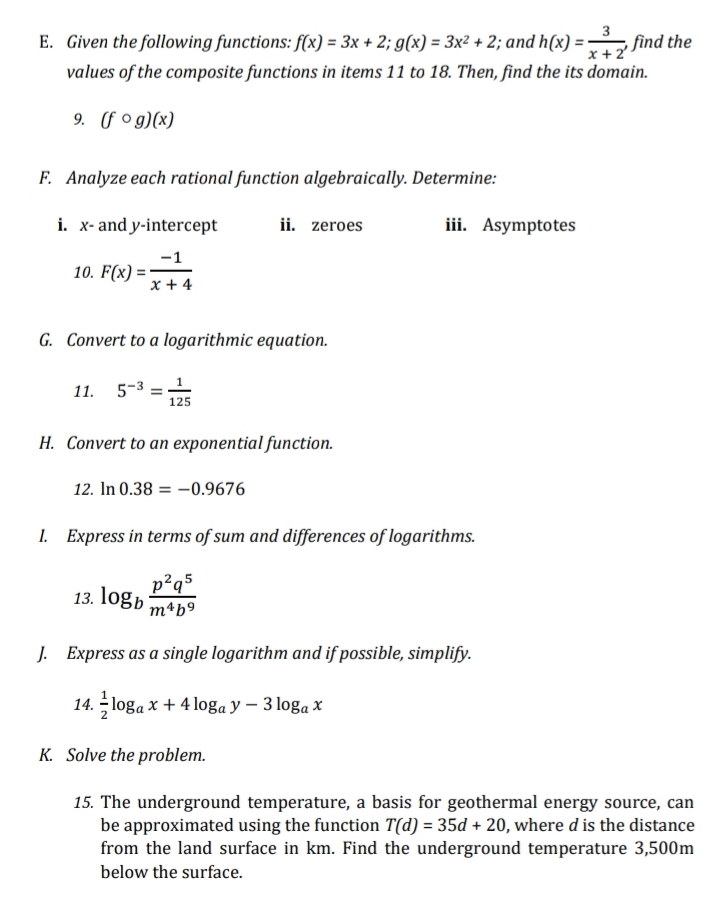College Algebra
7th Edition
ISBN:9781305115545
Author:James Stewart, Lothar Redlin, Saleem Watson
Publisher:James Stewart, Lothar Redlin, Saleem Watson
Chapter3: Polynomial And Rational Functions
Section: Chapter Questions
Problem 11T: Consider the following rational functions: r(x)=x2x22x1 s(x)=x2+4x3+27 t(x)=x+2x39x u(x)=x225x2+x6...
Related questions
Question
PLEASE ANSWER LETTER J AND K. THAANK U

Transcribed Image Text:x + 2
E. Given the following functions: f(x) = 3x + 2; g(x) = 3x² + 2; and h(x) = find the
values of the composite functions in items 11 to 18. Then, find the its domain.
9. (fog)(x)
F. Analyze each rational function algebraically. Determine:
i. x- and y-intercept
ii. zeroes
iii. Asymptotes
-1
10. F(x)=
x + 4
G. Convert to a logarithmic equation.
11. 5-31
125
H. Convert to an exponential function.
12. In 0.38 = -0.9676
1. Express in terms of sum and differences of logarithms.
13. logb m²b9
p²q5
J. Express as a single logarithm and if possible, simplify.
14. loga x + 4 loga y − 3 loga x
K. Solve the problem.
15. The underground temperature, a basis for geothermal energy source, can
be approximated using the function T(d) = 35d + 20, where d is the distance
from the land surface in km. Find the underground temperature 3,500m
below the surface.
Expert Solution
This question has been solved!
Explore an expertly crafted, step-by-step solution for a thorough understanding of key concepts.
Step by step
Solved in 2 steps with 2 images

Recommended textbooks for you

College Algebra
Algebra
ISBN:
9781305115545
Author:
James Stewart, Lothar Redlin, Saleem Watson
Publisher:
Cengage Learning

Algebra and Trigonometry (MindTap Course List)
Algebra
ISBN:
9781305071742
Author:
James Stewart, Lothar Redlin, Saleem Watson
Publisher:
Cengage Learning


College Algebra
Algebra
ISBN:
9781305115545
Author:
James Stewart, Lothar Redlin, Saleem Watson
Publisher:
Cengage Learning

Algebra and Trigonometry (MindTap Course List)
Algebra
ISBN:
9781305071742
Author:
James Stewart, Lothar Redlin, Saleem Watson
Publisher:
Cengage Learning


Algebra for College Students
Algebra
ISBN:
9781285195780
Author:
Jerome E. Kaufmann, Karen L. Schwitters
Publisher:
Cengage Learning


College Algebra (MindTap Course List)
Algebra
ISBN:
9781305652231
Author:
R. David Gustafson, Jeff Hughes
Publisher:
Cengage Learning